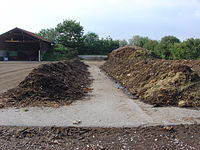
Enhanced bioreduction of nitrobenzene by reduced graphene oxide materials: effects of surface modification and coexisting soluble electron shuttles
Sign Up to like & getrecommendations! Published in 2017 at "Environmental Science and Pollution Research"
DOI: 10.1007/s11356-017-0673-z
Abstract: Reduced graphene oxide (rGO) can enhance the bioreduction of nitrobenzene by Shewanella oneidensis MR-1. The effects of surface modification and coexisting soluble electron shuttles on rGO-enhanced bioreduction of nitrobenzene were investigated here. The results showed… read more here.
Keywords: rgo; bioreduction; electron shuttles; bioreduction nitrobenzene ... See more keywords

Bioreduction of hexavalent chromium: Effect of compost-derived humic acids and hematite
Sign Up to like & getrecommendations! Published in 2020 at "Chinese Chemical Letters"
DOI: 10.1016/j.cclet.2020.04.001
Abstract: Abstract Composting can enhance the nutrient elements cycling and reduce carbon dioxide production. However, little information is available regarding the application of compost for the remediation of the contaminated soil. In this study, we assess… read more here.
Keywords: reduction; humic acids; compost; derived humic ... See more keywords

Microbially mediated iron redox cycling of subsurface sediments from Hanford Site, Washington State, USA
Sign Up to like & getrecommendations! Published in 2020 at "Chemical Geology"
DOI: 10.1016/j.chemgeo.2020.119643
Abstract: Abstract: Iron-bearing clay minerals are predominant in soils and sediments, and they undergo oxidation-reduction cycles as a result of natural processes such as wetting/drying cycles and plant root respiration. However, the kinetics and mechanisms of… read more here.
Keywords: redox cycles; redox; hanford; bioreduction ... See more keywords

The dynamic role of pH in microbial reduction of uranium(VI) in the presence of bicarbonate.
Sign Up to like & getrecommendations! Published in 2018 at "Environmental pollution"
DOI: 10.1016/j.envpol.2018.07.021
Abstract: The negative effect of carbonate on the rate and extent of bioreduction of aqueous U(VI) has been commonly reported. The solution pH is a key chemical factor controlling U(VI)aq species and the Gibbs free energy… read more here.
Keywords: presence; dynamic role; see text; formula see ... See more keywords

Application of enhanced bioreduction for hexavalent chromium-polluted groundwater cleanup: Microcosm and microbial diversity studies.
Sign Up to like & getrecommendations! Published in 2020 at "Environmental research"
DOI: 10.1016/j.envres.2020.109296
Abstract: Hexavalent chromium (Cr6+) is a commonly found heavy metal at polluted groundwater sites. In this study, the effectiveness of Cr6+ bioreduction by the chromium-reducing bacteria was evaluated to remediate Cr6+-contaminated groundwater. Microcosms were constructed using… read more here.
Keywords: hexavalent chromium; bioreduction; cr6; polluted groundwater ... See more keywords

Acceleration mechanism of bioavailable Fe(Ⅲ) on Te(IV) bioreduction of Shewanella oneidensis MR-1: Promotion of electron generation, electron transfer and energy level.
Sign Up to like & getrecommendations! Published in 2020 at "Journal of hazardous materials"
DOI: 10.1016/j.jhazmat.2020.123728
Abstract: The release of highly toxic tellurite into the aquatic environment poses significant environmental risks. The acceleration mechanism and tellurium nanorods (TeNPs) characteristics with bioavailable ferric citrate (Fe(III)) were investigated in the tellurite (Te(IV)) bioreduction. Experiments… read more here.
Keywords: acceleration mechanism; electron; bioreduction; electron transfer ... See more keywords

Dissimilatory bioreduction of iron(III) oxides by Shewanella loihica under marine sediment conditions.
Sign Up to like & getrecommendations! Published in 2019 at "Marine environmental research"
DOI: 10.1016/j.marenvres.2019.104782
Abstract: Shewanella is a genus of marine bacteria capable of dissimilatory iron reduction (DIR). In the context of deep-sea mining activities or submarine mine tailings disposal, dissimilatory iron reducing bacteria may play an important role in… read more here.
Keywords: iii oxides; shewanella loihica; bioreduction; iron ... See more keywords

Combined Effects of Fe(III)-Bearing Clay Minerals and Organic Ligands on U(VI) Bioreduction and U(IV) Speciation.
Sign Up to like & getrecommendations! Published in 2021 at "Environmental science & technology"
DOI: 10.1021/acs.est.0c08645
Abstract: Reduction of U(VI) to U(IV) drastically reduces its solubility and has been proposed as a method for remediation of uranium contamination. However, much is still unknown about the kinetics, mechanisms, and products of U(VI) bioreduction… read more here.
Keywords: clay minerals; presence; bioreduction; iii bearing ... See more keywords

Enhanced Bioreduction of Radionuclides by Driving Microbial Extracellular Electron Pumping with an Engineered CRISPR Platform.
Sign Up to like & getrecommendations! Published in 2021 at "Environmental science & technology"
DOI: 10.1021/acs.est.1c03713
Abstract: Dissimilatory metal-reducing bacteria (DMRB) with extracellular electron transfer (EET) capability show great potential in bioremediating the subsurface environments contaminated by uranium through bioreduction and precipitation of hexavalent uranium [U(VI)]. However, the low EET efficiency of… read more here.
Keywords: extracellular electron; crispr platform; engineered crispr; platform ... See more keywords

Effect of Siderophore DFOB on U(VI) Adsorption to Clay Mineral and Its Subsequent Reduction by an Iron-Reducing Bacterium.
Sign Up to like & getrecommendations! Published in 2022 at "Environmental science & technology"
DOI: 10.1021/acs.est.2c02047
Abstract: Uranium mining and nuclear fuel production have led to significant U contamination. Past studies have focused on the bioreduction of soluble U(VI) to insoluble U(IV) as a remediation method. However, U(IV) is susceptible to reoxidation… read more here.
Keywords: adsorption; dfob complex; bioreduction; clay mineral ... See more keywords

Biosorption and Bioreduction of Perchlorate Using the Nano-Fe3O4-Laden Quaternary-Ammonium Chinese Reed: Considering the Coexisting Nitrate and Nano-Fe3O4
Sign Up to like & getrecommendations! Published in 2017 at "ACS Sustainable Chemistry & Engineering"
DOI: 10.1021/acssuschemeng.6b02815
Abstract: Nano-Fe3O4-laden quaternary-ammonium Chinese reed has been prepared for perchlorate removal, and the laden perchlorate was bioreduced on the surface of the biosorbent by mixed perchlorate-reducing bacteria. Results of kinetics, isotherms, and computations revealed strong competitive… read more here.
Keywords: nano fe3o4; laden quaternary; perchlorate; fe3o4 laden ... See more keywords